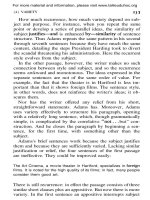Tài liệu Simple Measures to Reduce Energy Consumption pdf
Bạn đang xem bản rút gọn của tài liệu. Xem và tải ngay bản đầy đủ của tài liệu tại đây (468.55 KB, 8 trang )
PLANNING GUIDE
Creating the
Green Data Center
Simple Measures to Reduce Energy Consumption
in US Federal Government Facilities
Page 2
The continued thirst for energy
is a recurring story in news
headlines every day.
Global warming
forecasts rising temperatures, melting ice, and population
dislocations due to accumulation of greenhouse gases in
our atmosphere from use of carbon-based energy. There are
strong arguments for and against the dire predictions of global
warming, yet one fact is undeniable—over the past 10 to 20
years, the inhabitants of Earth are collectively consuming more
energy at a faster rate than ever before.
As part of the response to improve energy efficiency and
reduce greenhouse gas emissions, many parts of the Federal
government are instituting new policies. For example, Execu-
tive Order 13423, signed by the President on January 24, 2007,
created the Office of the Federal Environmental Executive.
OFEE is charged with promoting sustainable environmental
stewardship throughout the Federal government. OFEE recog-
nizes that electronics, particularly computer electronics, provide
an opportunity for improved energy consumption.
No where is this more apparent than in the data center where
power consumption has doubled in the past five years and is
expected to rise at a steeper rate of 76% from 2005 to 2010.
One culprit is steadily increasing power requirements for serv-
ers. For example, according to IDC (2006), the average small to
medium size server required 150 W of power in 1996. These
small to medium servers will require over 450 W by 2010. Of
course, increased power requirements means increased heat to
dissipate, driving another culprit for increased energy use in the
data center—cooling. One survey of IT executives shows that
45% of data center energy consumption goes to chiller/cooling
towers and computer room air conditioners (CRACs). Accord-
ing to IDC 2006, in the year 2000, for every $1 spent on new
servers, 21 cents was spent on power and cooling.
By 2010, IDC predicts that every $1 spent on new servers will
require 71 cents on power and cooling. This massive increase
has led to the formation of industry consortiums such as The
Green Grid
SM
that are specifically focusing efforts on lowering
power consumption in the data center.
Federal data centers offer great potential for energy savings,
which helps to reduce costs and improve performance while
supporting other critical Federal initiatives, such as information
sharing. On August 2, 2007, the US Environmental Protection
Agency ENERGY STAR program released its report to Congress
assessing the opportunities for improved energy efficiency in
both government and commercial data centers. The report
showed that data centers in the U.S. have the potential to save
up to $4 billion in annual electricity costs through more energy
efficient equipment and operations, and the broad implemen-
tation of best management practices.
There are many ways to promote conservation of electricity
in the data center. For example, server virtualization allows
multiple applications to run on individual servers, which means
fewer servers to power and cool. In practice, a data center may
be able to reduce the number of servers from 70 to 45, for
example. Virtualization recognizes that a server gives off 100%
of its heat if it is 20% or 90% in use. This dramatically reduces
power and cooling costs across the data center.
Yet there are many other ways to reduce power and cooling
costs in the data center—ways that are far simpler and less
expensive to implement.
Energy
Awareness
Driving Decisions in
the DataCenter
Introduction
Page 3
Airflow Management
in Cabinets
New server platforms can support 800 to 1,000+ optical fiber
terminations or 600-1000+ copper cable terminations per
chassis. The prospect of crowding too many cables into vertical
managers poses a problem for thermal management in cabi-
nets. When air cannot properly circulate in the cabinet, data
center fans are called upon to move more air and cooling units
to lower air temperature—both of which consume additional,
unnecessary electricity.
For years the IT industry has promoted the benefits of increased
rack and cabinet density. Servers are smaller than ever and
more can fit into the same space. The rationale has always
been to make the best use of data center floor space. Yet
today the balance is shifting. New servers are consuming more
energy than ever before, causing data center and facilities
managers to weigh spiking operating costs due to more energy
usage against the capital cost of “wasted” space of lower
density configuration in raised floor environments. Instead of
just focusing on density, energy efficiency demands that data
center and facilities mangers look at managed density.
Managed density recognizes that there really is a limit to the
number of cable terminations and servers that can safely and
economically be housed in cabinets. A prime issue is poten-
tial blocking of airflow caused by too many cables within the
cabinet. One solution is to limit the number of servers and
cable terminations in a cabinet, especially in copper racks
where cable diameter is larger. Another is to employ basic
cable management within the cabinet, such as securing
cables along the entire length of vertical cable managers to
open airflow. Similarly, integrated slack management systems
locate and organize patch cords so that maximum space is
available for flow of cool air into and out of the cabinet.
Using smaller diameter copper cable is another means to
improve airflow within the cabinet. For many data centers,
copper equipment terminations are still prevalent, especially
with the ability to push 10Gb/s over Augmented Category
6 cabling. The choice of copper cabling can impact airflow
because some cables have a much smaller outside diameter.
For example, ADC’s AirES technology provides superior con-
ductor insulation that allows cable to exceed standards for
electrical performance using smaller gauge copper and less
insulating material. The result is cable with an average out-
side diameter that is 28 to 32 percent smaller than standard
Category 6 or Category 6a cables. Less cable means reduced
blockage in the cabinet, allowing air to flow more freely and
do its important job of cooling equipment—which then uses
less electricity.
With proper cable management and smaller diameter cables,
cable fill ratio for vertical cable guides of 60 percent supports
higher density configurations without compromising airflow;
higher server density is possible without inducing added
electricity use for fans and cooling equipment.
Page 4
Airflow Management
in the Data Center
There are many simple solutions to improve overall airflow ef-
ficiency in the data center that can be implemented immedi-
ately, and without major changes in the design and layout of
the data center. In general, unrestricted airflow requires less
power for cooling efforts. Each incremental improvement
results in less energy to cool equipment—reducing costs
and limiting output of greenhouse gases from the power
company. These simple solutions include the following:
• Plugunnecessaryventsinraisedoorperforatedtiles.
• Plugotherleakagesintheraisedoorbysealingcable
cutouts, sealing the spaces between floors and walls, and
replacing missing tiles.
• Reduceairleakagebyusinggasketstotoortiles
more securely onto floor frames
• Ensurethatventedoortilesareproperlysituatedto
reduce hot spots and wash cool air into equipment
air intakes.
• Manageheatsourcesdirectlybysituatingsmallfansnear
the heat source of equipment.
• Usetimeofdaylightingcontrolsormotionsensorsto
dim the lights when no one is in the data center; lights
use electricity and generate added heat, which requires
added cooling.
• Reduceoveralldatacenterlightingrequirementsbyusing
small, portable lights within each cabinet, which puts
light where technicians need it.
• Turnoffserversnotinuse.
There are also many avenues for improving data airflow that
require more planning and execution. The most documented
and discussed is the hot aisle/cold aisle configuration for cabi-
nets. This design for the raised floor area effectively manages
airflow and temperature by keeping hot aisles hot and the cold
aisles cold. Aisles designated for cold air situate servers and other
equipment in cabinets so that air inlet ports face the cold aisle.
Similarly, hot air equipment outlets are situated in cabinets facing
only into the hot aisle. Cool air for the data center is only pushed
through perforated floor tiles into cold aisles; hot air from equip-
ment exhausts into the hot aisle.
Designing hot aisle/cold aisle presents its own
set of challenges, including the following:
• Ensuringthatcoolairsupplyowisadequatefor
the space
• Sizingaislewidthsforproperairow
• Positioningequipmentsohotairdoesnotre-circulate
back into equipment cool air inlets
• Addingorremovingperforatedoortilestomatchthe
air inlet requirements of servers and other active
equipment.
• Accountingforaisleends,ceilingheightandabovecabinet
blockages in airflow calculations.
Another ready means to improve cooling is removing block-
ages under the raised floor. The basic cable management
technique of establishing clearly defined cable routing paths
with raceway or cable trays under the floor keeps cables
organized, using less space and avoiding the tangled mess
of cables that can restrict airflow. Moving optical fiber cables
into overhead raceway as well as removing abandoned cable
and other unnecessary objects from below the floor also
improves airflow.
Dust and dirt are enemies of the data center. Dust has a way
to clogging equipment air inlets and clinging to the inside of
active equipment. All of this dust requires more airflow and
more cooling dollars in the data center. There is probably an
active program for cleaning above the raised floor. It is just
as important to periodically clean below the raised floor to
reduce dust and dirt in the air.
Cabinets Cabinets
Front
Rear
Cabinets
Telecom
Cable Trays
Perforated
Tiles
Perforated
Tiles
Power Cables
Telecom
Cable Trays
Power Cables
Front
Front
Rear
Rear
Page 5
There are many other initiatives that can be implemented
to improve airflow throughout the data center and reduce
energy costs. These include the following:
• Moveairconditioningunitsclosertoheatsources.
• Duringcoolermonthsandinthecooloftheeveningtime,
use fresh air instead of re-circulated air.
• Reducehotspotsbyinstallingblankingpanelstoincrease
CRAC air return temperature.
• Considerusingductedreturns.
According to APC (2006), implementing the hot aisle/cold
aisle configuration can reduce electrical power consumption
by 5 to 12 percent. This same study showed that even simple
measures such as proper location of perforated floor tiles
can reduce power consumption by as much as 6 percent. By
implementing even the smallest measures, power consump-
tion can be drastically reduced.
Clearly defined cable routing
paths keep cables organized,
using less space and avoiding
the tangled mess of cables
that can restrict airflow.
Moving optical fiber cables into
overhead raceways, opens up airflow
underneath floor panels









